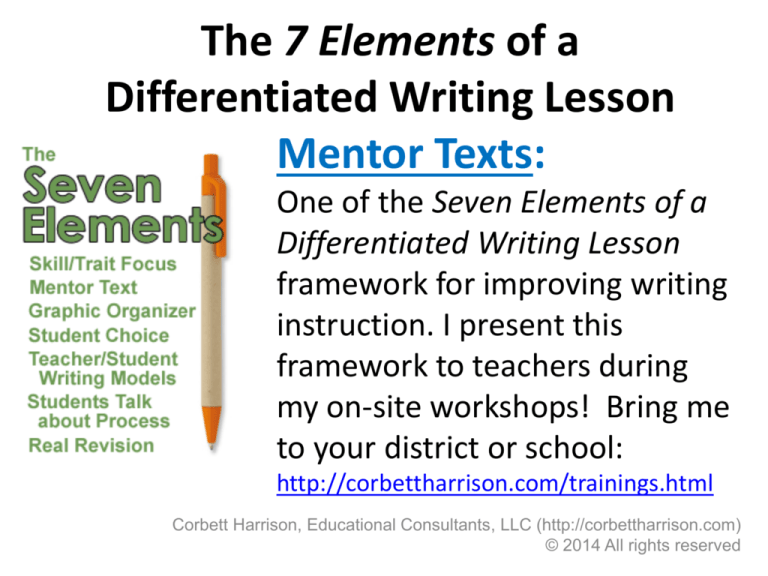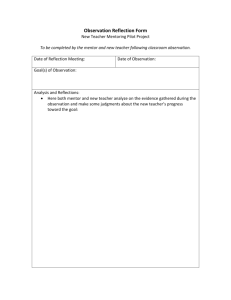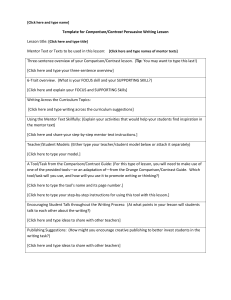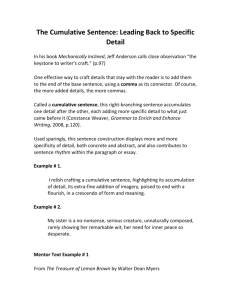
The 7 Elements of a
Differentiated Writing Lesson
Mentor Texts:
One of the Seven Elements of a
Differentiated Writing Lesson
framework for improving writing
instruction. I present this
framework to teachers during
my on-site workshops! Bring me
to your district or school:
http://corbettharrison.com/trainings.html
Corbett Harrison, Educational Consultants, LLC (http://corbettharrison.com)
© 2014 All rights reserved
The 7 Elements of a
Differentiated Writing Lesson
Hello, teaching colleagues! You’re looking at a partial version of the
“Mentor Text PowerPoint Presentation” that I share during my 2- and 3day professional development workshop: The Seven Elements of a
Differentiated Writing Lesson. You can purchase the entire PowerPoint
on mentor texts (as well as for the other 6 elements listed at left) at my
website. Like this PowerPoint, the materials are all self-paced for
independent learning, but they also can be shared whole staff.
In Nevada, California, and Oregon, I have presented and helped
implement the “7 Elements” framework at over three dozen schools
where the administrators had accepted that truly improving writing
instruction is not only important but also a long-term goal. The
framework allows for long-term goal-setting and monitoring.
During summer, I am available for hire to provide this 2- or 3-day
workshop for schools or districts willing to reimburse my travel and pay
my fees. I also have a week every fall and a week every spring where I
can hired. Visit this page for details.
Corbett Harrison, Educational Consultants, LLC (http://corbettharrison.com)
© 2014 All rights reserved
Essential Question: What’s the difference between an
idea mentor text, a structure mentor text, and a craft
mentor text?
Mentor Text, my definition: a published piece of writing whose
idea, whose structure, or whose written craft techniques can be
discussed by student writers during a writing lesson for the purpose
of inspiring them. I believe there are three types of these texts.
idea
structure
craft
mentor texts
mentor texts
mentor texts
This mentor text’s unique
or interesting idea is used
to inspire a fresh or unique
idea from your student
writers.
This mentor text provides a
structure that student
writers can “borrow” to
write about their own
unique ideas.
This mentor text contains
well-crafted writing
techniques that can be
analyzed and imitated by
student writers.
Essential Question: What’s the difference between an
idea mentor text, a structure mentor text, and a craft
mentor text?
Here is my 1st
example of an
idea mentor
text…
idea
mentor texts
This mentor text’s unique
or interesting idea is used
to inspire a fresh or unique
idea from your student
writers.
Cloudy with a Chance of Meatballs is a fun story about the
land of Chew-and-Swallow, where it rains different foods
for breakfast, lunch, and dinner every day. This is a unique
idea that can be used to inspire original ideas!
You might, for example,
challenge your students
to write about an original
day in the land of Chewand-Swallow, using foods
that were not used in the
original text. Or you
might invent an original
land where something
else unusual rains from
the sky.
Essential Question: What’s the difference between an
idea mentor text, a structure mentor text, and a craft
mentor text?
Here is my 2nd
example of an
idea mentor
text…
idea
mentor texts
This mentor text’s unique
or interesting idea is used
to inspire a fresh or unique
idea from your student
writers.
The most memorable chapter from Homer Price has to be
the chapter about the automatic doughnut machine that
goes a little haywire, making way too many doughnuts.
An automatic food-making machine is a unique idea!
You could have your
students create original
written descriptions
about automated
machines that they wish
they owned. You could
even have kids draw and
then “market” their
original machines to each
other!
Essential Question: What’s the difference between an
idea mentor text, a structure mentor text, and a craft
mentor text?
Here is my 3rd
example of an
idea mentor
text…
idea
mentor texts
This mentor text’s unique
or interesting idea is used
to inspire a fresh or unique
idea from your student
writers.
In chapter 3 of Lord of the Flies, two characters describe
the same exact same setting (the unexplored jungle); one
sees the jungle as a dangerous place; the other describes
the jungle as a beautiful and mysterious place. Unique!
Students could think of a
setting—a real one or an
imaginary one—and then
think of two characters
who would feel different
about the place. They
could write about the
same setting from two
different perspectives,
showing how differently
the two see things.
Essential Question: What’s the difference between an
idea mentor text, a structure mentor text, and a craft
mentor text?
Here is my 1st
example of a
structure
mentor text…
structure
mentor texts
This mentor text provides a
structure that student
writers can “borrow” to
write about their own
unique ideas.
Margaret Wise Brown’s The Important Book is probably the
most widely used “structure mentor text.” It provides a
simple-to-follow pattern that is repeated on every page,
each page exploring a different topic: wind, apples, etc.
Students can write
“Important Book-inspired”
passages about any topics
of study—science, history,
geography—or about more
personal topics they have a
connection to. The book’s
very safe structure can be
used to write about any
topic. If you don’t know
this book, ask a colleague.
Essential Question: What’s the difference between an
idea mentor text, a structure mentor text, and a craft
mentor text?
Here is my 2nd
example of a
structure
mentor text…
structure
mentor texts
This mentor text provides a
structure that student
writers can “borrow” to
write about their own
unique ideas.
Stories like Duck on a Bike utilize storytellers’ “series of
three” pattern (remember Goldilocks?). In this story, a
Duck rides a bike across the farm; 3 different animals each
stop, observe, and make three different commentaries.
Students can use this
story’s pattern to create an
original story about pretty
much anything: something
unusual can happen, and
three different animals or
characters all have a
moment to react to it. Add
an introduction and a
conclusion, and you have a
complete story!
Essential Question: What’s the difference between an
idea mentor text, a structure mentor text, and a craft
mentor text?
Here is my 3rd
example of a
structure
mentor text…
structure
mentor texts
This mentor text provides a
structure that student
writers can “borrow” to
write about their own
unique ideas.
Jim Croce’s song, “I Gotta Name” has three different
stanzas. Each song stanza focuses on a different thing the
singer carries around with him as he walks down the “road
of life.” The three things are: a name, a song, and a dream.
Students can create
original three-stanza
poems about walking
down “life’s road.” Each
stanza of the poem can
explore one important
item the poet plans to
carry with him/her as they
“take on the world” when
they become independent
adults.
Essential Question: What’s the difference between an
idea mentor text, a structure mentor text, and a craft
mentor text?
Here is my 1st
example of a
craft mentor
text…
craft
mentor texts
This mentor text contains
well-crafted writing
techniques that can be
analyzed and imitated by
student writers.
Julius Lester’s Sam and the Tigers contains wonderful color
similes, fresh and lively, not the forced similes our students
sometimes write when we ask them to revise. Each piece
of Sam’s clothing is described with this type of simile.
Students can analyze and
discuss what makes the
similes in this book “fresh”
and “not forced.” They can
then write something new
(a color poem, perhaps) or
revise a piece of writing,
making sure to use fresh
similes that Julius Lester
would be proud to know
he inspired from them.
Essential Question: What’s the difference between an
idea mentor text, a structure mentor text, and a craft
mentor text?
Here is my 2nd
example of a
craft mentor
text…
craft
mentor texts
This mentor text contains
well-crafted writing
techniques that can be
analyzed and imitated by
student writers.
Anything by Patricia MacLachlan is just amazingly wellcrafted. In All the Places to Love, one of the techniques
used when describing her childhood home in the country is
to begin her sentences with a variety of prepositions.
Students can analyze and
discuss how beginning
some sentences with
prepositions (instead of
using I and the all the time)
can create a series of
sentences that have more
flow to them. Students can
revise a setting description,
changing just some of the
sentences to begin this way.
Essential Question: What’s the difference between an
idea mentor text, a structure mentor text, and a craft
mentor text?
Here is my 3rd
example of a
craft mentor
text…
craft
mentor texts
This mentor text contains
well-crafted writing
techniques that can be
analyzed and imitated by
student writers.
Ralph Fletcher’s Marshfield Dreams is his autobiography.
One style technique Fletcher is so skilled with is his use of
subtle alliteration. His descriptions very subtly place verbs
and adjectives together so the sounds play off one another.
Students can analyze and
discuss any of the short
chapters from this book,
looking for instances of
subtle alliteration. They can
then be prompted to look in
their own writing for places
where subtle alliteration
would add to the writing,
perhaps making it more fun
to read aloud.
Essential Question: What’s the difference between an
idea mentor text, a structure mentor text, and a craft
mentor text?
Here’s what I believe about Mentor Texts:
Most teachers, I am pretty sure, already know a lot about using idea
and structure mentor texts to inspire their student writers. In my
workshop, participants newly embrace the idea of using craft mentor
texts as a powerful way to teach specific writing skills and revision.
We spend a lot of time exploring all three types, but our craft mentor
text discussions are generally the most appreciated by teachers.
idea
structure
craft
mentor texts
mentor texts
mentor texts
This mentor text’s unique
or interesting idea is used
to inspire a fresh or unique
idea from your student
writers.
This mentor text provides a
structure that student
writers can “borrow” to
write about their own
unique ideas.
This mentor text contains
well-crafted writing
techniques that can be
analyzed and imitated by
student writers.
Essential Question: What’s the difference between an
idea mentor text, a structure mentor text, and a craft
mentor text?
A Task for You:
Look through your favorite texts on your classroom bookshelf, starting
with those you already use to inspire student writers. Begin classifying
them as idea, structure, or craft mentor texts. Did you find gaps like I
did when I did this task? Can you adapt lessons at my website’s Mentor
Text Page to help begin filling those gaps? Do your colleagues have gapfilling lessons they might share with you? Look into it!
idea
structure
craft
mentor texts
mentor texts
mentor texts
This mentor text’s unique
or interesting idea is used
to inspire a fresh or unique
idea from your student
writers.
This mentor text provides a
structure that student
writers can “borrow” to
write about their own
unique ideas.
This mentor text contains
well-crafted writing
techniques that can be
analyzed and imitated by
student writers.
The 7 Elements of a
Differentiated Writing Lesson
Hello, teaching colleagues! You’re looking at a partial version of the
“Mentor Text PowerPoint Presentation” that I share during my 2- and 3day professional development workshop: The Seven Elements of a
Differentiated Writing Lesson. You can purchase the entire PowerPoint
on mentor texts (as well as for the other 6 elements listed at left) at my
website. Like this PowerPoint, the materials are all self-paced for
independent learning, but they also can be shared whole staff.
In Nevada, California, and Oregon, I have presented and helped
implement the “7 Elements” framework at over three dozen schools
where the administrators had accepted that truly improving writing
instruction is not only important but also a long-term goal. The
framework allows for long-term goal-setting and monitoring.
During summer, I am available for hire to provide this 2- or 3-day
workshop for schools or districts willing to reimburse my travel and pay
my fees. I also have a week every fall and a week every spring where I
can hired. Visit this page for details.
Corbett Harrison, Educational Consultants, LLC (http://corbettharrison.com)
© 2014 All rights reserved




